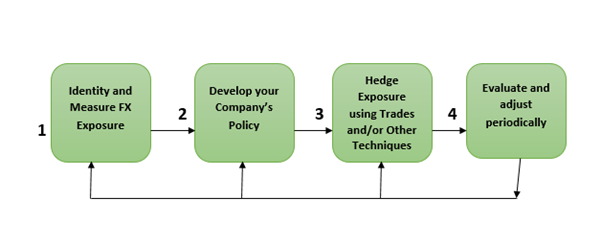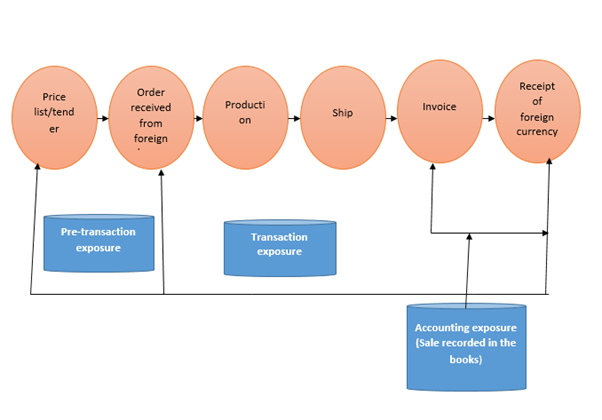Foreign Exchange Risk Exposure Management
Foreign exchange risk, also termed as FX risk, exchange rate risk or currency risk is a financial risk that occurs when a financial deal is denominated in a currency other than that of the base currency of the company. This type of risk also exists when the foreign subsidiary of a firm maintains financial statements in a currency other than the reporting currency of the combined entity. The risk is that there may be an opposing movement in the exchange rate of the denomination currency in relation to the base currency before the date when the transaction is completed (Levi, 2005). Depositors and businesses exporting or importing goods and services or making foreign investments have an exchange rate risk which can have severe financial consequences; but steps can be taken to lessen the risk. This risk frequently affects businesses that export and/or import. It also affects investors making international investments. Many financial reports signified that financial risk management is the practice of creating economic value in a firm by using financial instruments to manage exposure to risk FOREX-Management of exposure risks. Foreign Exchange Exposure is a measure of the potential change in a firm's profitability, net cash flow and /or market value of net assets due to a change in exchange rates.
Types of Exposure
- Transaction Risk
- Translation Risk
- Economic Risk
Transaction Exposure
Business Company has transaction exposure whenever it has contractual cash flows (receivables and payables) whose values are subject to unexpected changes in exchange rates due to a contract being denominated in a foreign currency. To realize the domestic value of its foreign-denominated cash flows, the firm must exchange foreign currency for domestic currency. As firms negotiate contracts with set prices and delivery dates in the face of a volatile foreign exchange market with exchange rates constantly fluctuating, the firms face a risk of changes in the exchange rate between the foreign and domestic currency. It denotes to the risk associated with the change in the exchange rate between the time an enterprise initiates a transaction and settles it.
Economic Exposure
A firm has economic exposure also called forecast risk to the degree that its market value is influenced by unexpected exchange rate fluctuations. Such exchange rate adjustments can rigorously affect the firm's market share position with regards to its competitors, the firm's future cash flows, and finally the firm's value. Economic exposure can affect the present value of future cash flows. Any transaction that exposes the firm to foreign exchange risk also exposes the firm economically, but economic exposure can be caused by other business activities and investments which may not be mere international transactions, such as future cash flows from fixed assets. A swing in exchange rates that influences the demand for goods in some country would also be an economic exposure for a firm that sells goods. Economic Exposures cannot be fudged as well due to limited data, and it is expensive and time consuming. Economic Exposures can be managed by, product variation, pricing, branding, outsourcing.
Translation Exposure
A firm's translation exposure is the extent to which its financial reporting is affected by exchange rate movements. As all companies generally must prepare consolidated financial statements for reporting purposes, the consolidation process for multinationals entails translating foreign assets and liabilities or the financial statements of foreign subsidiaries from foreign to domestic currency. While translation exposure may not affect a firm's cash flows, it could have a noteworthy impact on a firm's reported earnings and therefore its stock price. Translation exposure is distinguished from transaction risk as a result of income and losses from various types of risk having different accounting treatments.
Firms with exposure to foreign exchange risk may use a number of foreign exchange hedging strategies to reduce the exchange rate risk. Transaction exposure can be reduced either with the use of the money markets, foreign exchange derivatives such as forward contracts, futures contracts, options, and swaps, or with operational techniques such as currency invoicing, leading and lagging of receipts and payments, and exposure netting (Eun, 2011).
Companies may espouse alternative strategies to financial hedging to manage their economic or operating exposure, by carefully selecting production sites with a mind for lowering costs, using a policy of flexible sourcing in its supply chain management, diversifying its export market across a greater number of countries, or by implementing strong research and development activities and differentiating its products in pursuit of greater inelasticity and less foreign exchange risk exposure (Eun, 2011).
Translation exposure is mainly dependent on the accounting standards of the home country and the translation techniques required by those standards. It can be explained through example of the United States Federal Accounting Standards Board, which specifies when and where to use certain methods such as the temporal method and current rate method. Firms can manage translation exposure by performing a balance sheet hedge. Since translation exposure rises from inconsistencies between net assets and net liabilities on a balance sheet solely from exchange rate differences. Following this logic, a firm could acquire an appropriate amount of exposed assets or liabilities to balance any outstanding discrepancy. Foreign exchange derivatives may also be used to hedge against translation exposure (Eun, 2011).
Hedging Transaction Risk - The Internal Techniques
Internal methods to manage/reduce forex exposure should always be considered before external methods on cost grounds. Internal techniques include the following: Invoice in home currency: Simple procedure is to insist that all foreign customers pay in home currency and that company pays for all imports in your home currency. However the exchange-rate risk has not gone away, it has just been passed onto the customer. Customer may not be happy with strategy and simply look for an alternative supplier.
Achievable if companies are in a monopoly position, however in a competitive environment this is an impractical approach.
Leading and lagging: If an importer assumes that the currency it is due to pay will depreciate, it may attempt to delay payment. This may be realized by agreement or by exceeding credit terms.
If an exporter expects that the currency it is due to receive will depreciate over the next three months it may try to obtain payment immediately. This may be achieved by offering a discount for immediate payment.
The problem lies in predicting which way the exchange rate will move.
For some companies, it is complex process, expensive and time consuming to manage foreign exchange risk. Other companies may not know about hedging instruments and techniques or believe that hedging is a speculative activity. Yet companies that choose not to manage foreign exchange risk may be assuming that exchange rates will remain at their present levels or move in a direction that will be favourable to the company-something that closely resembles speculation.
Bulk of studies have established that managing this risk can effectively reduce company's foreign exchange exposure. Managing foreign exchange risk has numerous benefits to many multinational companies:
- Decrease the effects of exchange rate movements on profit margins.
- Increase the predictability of future cash flows.
- Eliminate the need to precisely forecast the future direction of exchange rates.
- Assist the pricing of products sold on export markets.
- Protect, temporarily, a company's competitiveness if the value of the currency rises.
If a risk can be reduced at a reasonable cost, then it is generally accepted that steps should be taken by managers to protect their companies. The decision to purchase foreign exchange hedging instruments is similar to the one made when the company buys other forms of insurance.
The insured risk is the reduction in cash flows and profit margins caused by adverse changes in an exchange rate. Many firms do not hesitate to protect their accounts receivable from the risk of non-payment and all firms obtain property and casualty insurance. They do so in order to safeguard cash flow and ensure that the company's efforts and talent are focused on its core business activities. Many companies involved in international trade view foreign exchange risk management this way.
Steps to manage foreign exchange risk

Step one encompasses recognising and measuring the foreign exchange exposures that managers want to manage. The focus for most companies is on transaction risk. Once managers have calculated exposure, they need to develop your company's foreign exchange policy as part of step two.
Transaction exposure can begin much earlier than accounting exposure. As well, pre-transaction exposure cannot be overlooked as selling prices, once quoted, can rarely be changed in today's global marketplace. Therefore company must carefully assess when to start hedging its exposure.
Pre-Transaction, Transaction and Accounting Exposure

Step three comprises of putting in place hedges that are consistent with company's strategy. For example, if managers may want to increase the value of raw materials imported from the U.S. to partly offset the exposure created by sales to U.S. buyers. Alternatively, they may put in place basic financial hedges with a bank or foreign exchange broker.
Step four requires that officials intermittently measure whether the hedges are effectively reducing their company's exposure. It is better to establish clear objectives and benchmarks in order to facilitate this evaluation. It will also lessens the fear of those responsible for implementing the policy that they have somehow failed if the exchange rate moves in the company's favour and the hedges they put in place prevent the company from benefiting from that move.
To summarize, Foreign-Exchange Risk is basically risk of an investments value changing due to deviations in currency exchange rates. The risk that an investor will have to close out a long or short position in a foreign currency at a loss due to an adverse movement in exchange rates. It is also termed as "currency risk" or "exchange-rate risk". Foreign exchange exposure is the risk related with activities that involve an international firm in currencies other than its home currency. Fundamentally, it is the risk that a foreign currency may move in a direction which is financially disadvantageous to the international firm.

